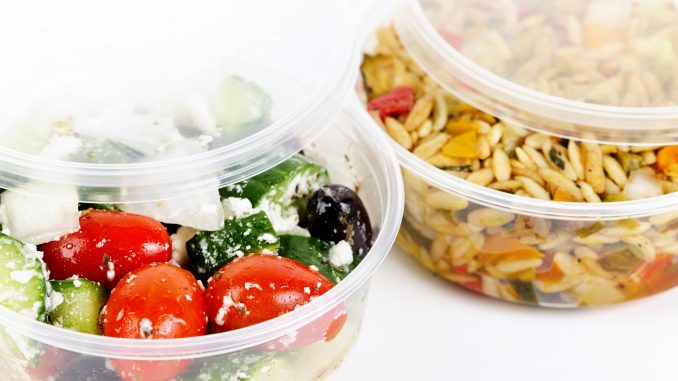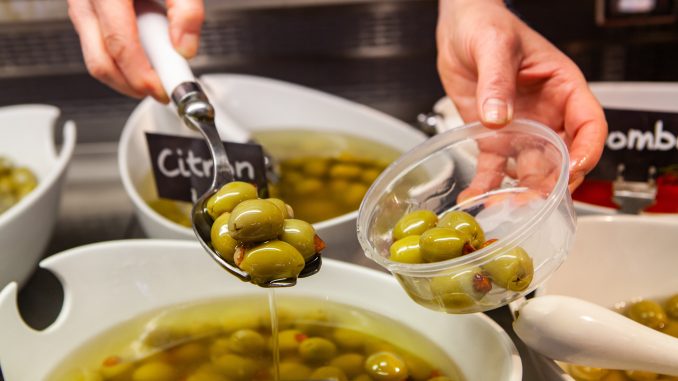Benefits of Single-Use Plastic Packaging
April 1, 2020 | 8 min to read
In 2020, supermarkets increasingly used plastic packaging for items like fresh cut fruit and ready-to-eat meals to cater to busy consumers seeking convenience. Mark Marinozzi of World Centric noted a growing willingness to pay for environmentally-friendly options, while Derek Skogen of Placon emphasized the importance of attractive, functional packaging for on-the-go meals. Trends also involve less plastic usage through hybrid materials and recycled content, as highlighted by Peggy Cross of EcoTensil.

In 2020, consumers see plastic packaging used in a variety of methods and functionalities within the supermarket delis, ranging from fresh cut fruit to sandwiches to convenient, ready-to-eat take home entrée meals.
Mark Marinozzi, vice president of marketing for World Centric, based in Petaluma, CA, says single-use packaging is expanding rapidly, driven by changing life- styles of busy U.S. consumers and their increased consumption of on-the-go food.
“They are willing to pay more to do the right thing if they know they are getting their food in an environmentally-friendly, disposable packaging solution—made from rapid renewable molded fibers or plant-based plastics—versus a non-green—wood tree fiber or petroleum-based plastic— pack- age,” he says.
Derek Skogen, senior product manager for Placon, headquartered in Madison, WI, says with consumers looking for more con- venient products, stores are having to cater to provide more on-the-go choices and meal ready options, but making sure these stay fresh, and appearance on the shelf is important to the customer.
“Nobody wants to pick up a container with everything mushed together— appearance does help sell,” he says. “Many of the plastic packaging options found in the deli section today will provide custom- ers with a cold or hot application option. In most cases, the hot application options will be packaged in a material type that can be placed in an oven or microwave, truly making that food choice and package option a one-stop-shop that the consumer can purchase, prepare and dispose of in the package once dinner is complete.”
Zach Adams, global product line manager for Milliken, a package manufacturer in Spartanburg, SC, says consumers shop- ping the deli departments at supermarkets are interested in clarity first and foremost.
“People want to see the quality of the food and transparency in the package,” he says. “People are on the go, so convenience is key today. If they want something hot for lunch, they want to be able to microwave it, and there are some single-use plastic packaging that is good for that.”
Polypropylene packaging, he explains, is the best for that, as it’s the most heat resistant and microwavable of all the major plastic types.
“As retailers become more sophisticated with fresh-serve offerings, there will con- tinue to be a big demand for this sort of packaging,” says Adams.
Peggy Cross, founder and CEO of EcoTensil, based in Corte Madera, CA, recently took her annual month of travel in the EU and UK researching the fast-pasted shifts in plastic packaging for grab-and-go products, and delis in particular, and saw some significant trends and changes.
“At the packaging innovation conference in Birmingham, after much vigorous debate, it is acknowledged that perfect solutions do not exist, but everyone is clearly and ener- getically striving for improvement,” she says. “Much of the demand is coming from the retailers, also present at the show, who are responding to vociferous outcry from their customers.”
She revealed there is a shift towards using much less plastic, with an understand- ing that some plastic use is necessary and important. This shift includes light-weight- ing plastic by combining with paperboard for strength, using a molded paper fiber salad tray base combining it with a plastic lid for viewing or incorporating a paperboard tray with a removable plastic window.
“Recycled and recyclable plastics are being heavily pursued, including transpar- ent and active work with stakeholders in reclaiming these materials,” says Cross. “It was clear that most wanted some govern- ment regulation to keep the playing field even, such as a tax on using virgin plastic to create more value for recyclers to collect this material.”

The Evolution
Increased legislation in the past five to 10 years banning polystyrene, single use petroleum-based plastics in packag- ing and heightened consumer awareness have fueled the rise of using compostable packaging and reusables. One indicator is
that U.S. plant-based plastics demand has grown by over 20 percent.
Over the past decade, the deli section has expanded significantly with on-the-go convenience options, meal ready and grab- and-go sandwiches or snack options.
“As consumers continue looking for ready-made meals and convenience type foods, we are seeing the appearance of the food within the package and shelf life be very important when it comes to products and the sell through of these products,” says Skogen. “We are seeing retailers ask for extended shelf-type barrier packaging products, to help extend product shelf life and reduce product waste.”
He explains most barrier materials sim- ply absorb oxygen within the package to help keep the product fresher longer.
“We expect to see continued growth in the snacking and convenience type products arena, as more brands and products continue to enter this space based on market demand with consumer on-the-go lifestyles,” says Skogen.
New and Improved
Placon has introduced a variety of products in the single-use category over the past few years that directly influence and impact this deli space.
For example, its HomeFresh Entrée product line caters to ready-made meals.
“You have a variety of single-, two- or three-compartment base options that can be placed directly in the microwave to heat the food, and consumers can eat from the container and recycle it,” says Skogen. “Each base option incorporates a vented lid to release steam and moisture from the product during heating and also offers a post-consumer recycled PET lid that gives you a clearer view of the product and is 100 percent recyclable.”
In 2020, the company introduced its reFresh Parfait Cups focused directly on consumer convenience. Each cup has a built-in tamper-evident feature to ensure products are kept fresh and not tampered with prior to consumption.
“These cups come in three different lid options (dome, flat, pedestal) and include a three insert options to help retailers keep ingredients fresher longer on the shelf,” says Skogen. “It gives the retailers stability with portion control and the ability to showcase a better product by having your blueberries in the insert tray, which keeps them looking fresh so that the consumer can add them to the yogurt when ready to eat.”
Each cup is made using 75 percent or more post-consumer recycled PET plastic and are 100 percent recyclable.
World Centric offers more than 350 SKUs of rapid renewable (sugarcane bagasse, bamboo, wheat straw) molded fiber products, including plates, bowls and containers as well as plant-based plastic (PLA) deli containers, cutlery, cold cups and waste bags. It also offers a complete line of sustainably-produced paper hot cups, cold cups and soup bowls.
“Our newest packaging products include the NoTree 100 percent plant- based paper hot cups, bowls and cold cups, molded fiber lids, plant-based molded fiber PizzaRounds and FSC (Forest Stewardship Council) certified kraft paper straws,” says Marinozzi. “World Centric products are made from annually renewable plants like wheat, sugarcane and corn, use less energy to manufacture, are approved for food use by the FDA and, most importantly, are 100 percent compostable and break down into healthy soil in a commercial composting facility.”
Top Materials
Today’s retailers are asking for sustain- able packaging materials, as they try to achieve and promote corporate sustainability initiatives.
Skogen notes Placon has been using post-consumer content since the early ’90s and opened its very own recycling process facility in 2011 to bring this entire process on site at its Madison location.
“In most cases, any of our food prod- ucts made using PET are produced using our EcoStar, post-consumer recycled PET that is curbside collected bottles and ther- moforms that we bring back to our facility to process back in PET flake, turned into PET plastic sheet and made back into reus- able plastic packaging for food and retail,” says Skogen. “If it came from Placon, chances are it was made using post-con- sumer recycled PET material and can be used again and again if recycled correctly.”
It’s no secret that consumers are drawn to items that are recyclable and are even willing to pay a bit more for packaging that is good for the environment. Adams notes that has led to a shift from some polymers like polystyrene or foam polystyrene, which are not recyclable at all.
“Consumers are demanding retailers and brands make the shift into more sus- tainable plastics,” he says. “Additionally, a new trend is making the single-use pack- ages reusable. This is packaging that is dishwasher safe while keeping the recyclability. Consumers can decide whether or not to reuse or recycle.”
Many throughout the chain have begun this necessary journey towards a New Plastics Economy. At most packaging manufacturers, the “reduce, reuse, recycle” ethos is at the center of its sustainability thinking and technological innovation.
“We are developing new partnerships and solutions to help converters manu- facture more sustainably,” says Adams. “Our solutions reduce energy use, enable the substitution of more environmentally friendly materials and promote the recyclability of resins, such as polypropylene (PP) or the use of a higher percentage of recycled PP in end products.”

Pros of Single-Use Containers
There are a variety of studies in the market today exploring the benefits of sin- gle-use plastic packaging, and the demand for this packaging is higher than ever.
“Studies we have found and used do support that plastic packaging has a lower carbon footprint to produce, recycle and remake than bags, glass or other corrugated and sustainability (corn, pulp) type packaging products,” says Skogen.
He notes that by using plastic pack- aging, it results in longer-lasting product shelf-life (may have to use barrier mate- rials in some cases depending on the product) and a better appearance when compared to bags or cardboard box type packaging.
“The consumer can see the product better and view the freshness of the items,” he says. “It can also help increase product sell through.”
For example, Placon had a customer using a corrugate muffin container and the consumer could not see the prod- uct well so it switched them to its plastic muffin tray. Within the first month, the retailer saw an increase of 50 percent in muffin sales using the new container that was also made using post-consumer recycled content, and the product was 100 percent recyclable.
Marinozzi says World Centric can play a part in any retailer’s sustainability efforts, while helping its employees and customers minimize environmental impacts.
“Purchasing responsibly produced, plant-based foodservice products from World Centric has an immediate positive impact on a retailer’s brand, including being able to show support of our donations of 25 percent of pre-tax profits to grassroots global social and environmental causes,” says Marinozzi. “Using plant-based, 100 percent compostable packaging products helps a retailer minimize waste throughout their locations.”
Adams adds that plastic is not a bad thing and should be the future of sin- gle-serve packaging. DB
3 of 8 article in DeliBusiness Apr/May 2020

